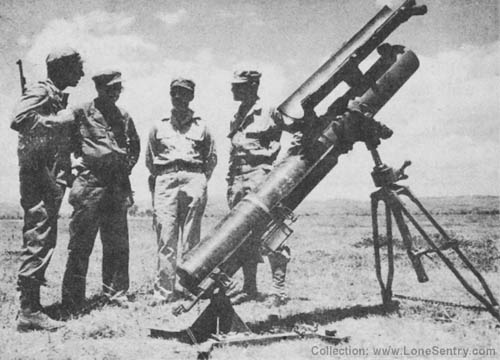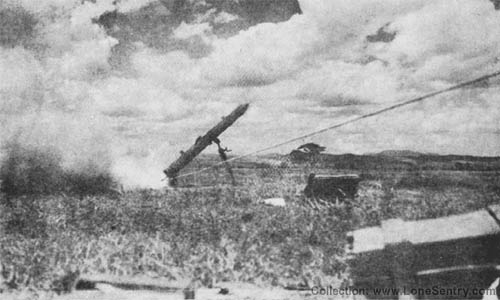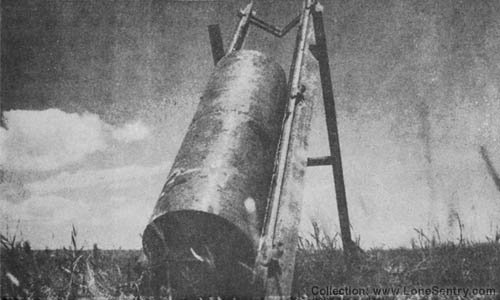The following U.S. intelligence report on Japanese spin-stabilized rockets and launchers was published in Enemy on Luzon: An Intelligence Summary:
ARMY 20-CM SPIN STABILIZED ROCKET AND TYPE 4 LAUNCHER:
Several of these projectiles, the first Army rockets recovered, and the Type 4 launcher, were used against our troops in the Manila area and east of Manila. The date of manufacture, late 1944, emphasized the trend toward increased use of rockets by the enemy.
In general appearance the launcher was similar to a large trench mortar. It incorporated traversing mechanism in the bipod and employed standard mortar fire-control devices. The tube, 20.3-cm inside diameter and 75 and 5/8 inches long, was open at both ends and contained a hinged opening for insertion of the rocket. It was fired with a 25-foot lanyard attached to a pull igniter.
Army 20-cm SS Rocket and Type 4 Launcher
The explosive head was a thin-walled tube containing nose fuze, booster and filling of cast TNT. The motor threaded onto the explosive head and was equipped with six nozzles canted 25 degrees. The propellant was ballistite ignited by a black powder charge located just forward of the igniter, which screwed into the motor base plate. Projectile and motor had a combined weight of approximately 185 pounds.
Army 20-cm SS Rocket and Type 4 Launcher (Firing)
The rocket was stable in flight, exploded high order, and had an approximate range of 3,200 yards at 800 mils.
NAVAL 20-CM SPIN STABILIZED ROCKET AND IMPROVISED LAUNCHERS:
The Japanese 20-cm Naval SS Rockets and Launchers were first recovered from coconut log emplacements facing out to sea near San Jose, Leyte. There were no indications that any of the rockets had been fired on our landing forces, although one rocket was found in place on the launcher, fully fuzed and ready for firing.
The overall length of this rocket was 37¼ inches. Right hand rotation stabilized the projectile in flight. It had a much higher charge weight ratio than any other known Naval ammunition (35.3%).
Two types of launchers were recovered. One launcher was a multiple type, capable of launching three rockets simultaneously. The other was a single-troughed launching rack with an adjustable bipod. Launchers on Leyte were constructed of metal, whereas those of similar design founds on Luzon were made of wood.
This spin stabilized rocket was designed as a short range weapon for a blast rather than a fragmentation effect. Maximum range fired from the open launching racks was reported to be 1,800 meters. Targets fired upon could not have been seen from the pillbox emplacements found. Also, the lack of a traversing mechanism and a means of changing elevation without manually shifting the front bipod would have hindered making corrections on the target.
447-MM SPIN STABILIZED ROCKET AND CART TYPE LAUNCHER:
The launcher and eighty-five rockets were recovered in the Manila area, where they reportedly were brought a month before our landing in Lingayen Gulf, It is not known whether the weapon was used against our troops.
The rocket was 447-mm in diameter, weighed roughly 1,500 pounds, and consisted of an explosive head 41¼ inches long and a motor 27 inches long. The head was a 3/4 inch steel barrel, filled with picric acid, to which was welded a nose containing a fuse, picric acid booster cylinder and an Army gaine. For the propellant charge the motor used 60 kg of ballistite sticks, ignited by a charge of black powder located forward of the central stick. The motor base plate was equipped with six canted nozzles, a propellant-restraining grill, a threaded recess for the primer and a light protective base cover. By flashing through the perforation in the central ballistite stick, the primer ignited the black powder.
447-mm SS Rocket
With 4-foot wooden wheels and a 12-foot wooden launching platform, the launcher resembled a two-wheeled cart. The firing mechanism, wheel brakes, and general construction were very crude, suggesting that the design was a field expedient.
The rocket was stable in flight, had an approximate range of 2,150 yards at 800 mils elevation, exploded high order with good fragmentation, and produced a crater resembling that of a U.S. 1,000-pound bomb.













Thanks. Very useful resource.
The Japanese military was so far behind in their rocket technology, especially when you compare with what the U.S. and Germans were deploying by 1945.